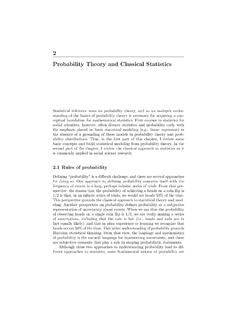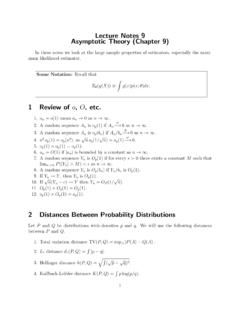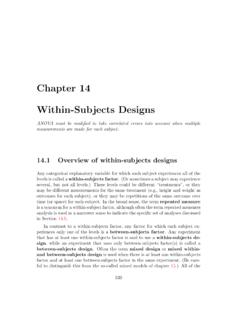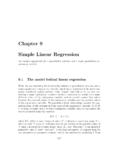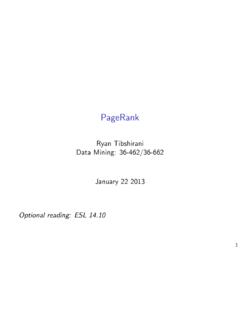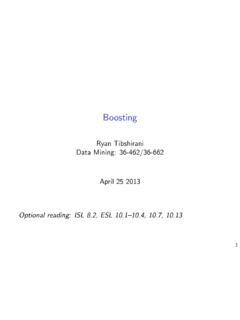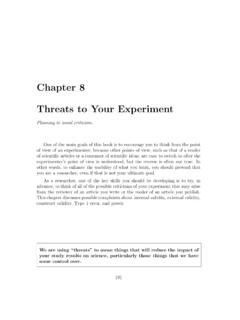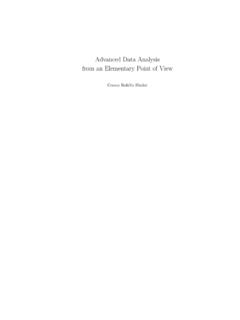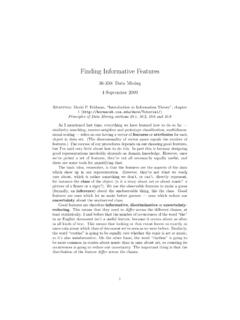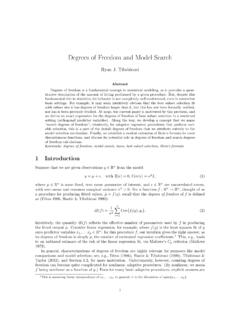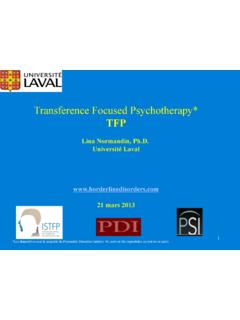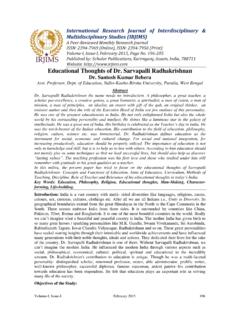Transcription of Chapter 7 One-way ANOVA - Carnegie Mellon University
1 Chapter 7 One-way ANOVAOne-way ANOVA examines equality of population means for a quantitative out-come and a single categorical explanatory variable with any number of t-test of Chapter 6 looks at quantitative outcomes with a categorical ex-planatory variable that has only two levels. The one-wayAnalysis of Variance( ANOVA ) can be used for the case of a quantitative outcome with a categoricalexplanatory variable that has two or more levels of treatment. The term One-way , also called one-factor, indicates that there is a single explanatory variable( treatment ) with two or more levels, and only one level of treatment is appliedat any time for a given subject. In this Chapter we assume that each subject is ex-posed to only one treatment, in which case the treatment variable is being applied between-subjects . For the alternative in which each subject is exposed to severalor all levels of treatment (at different times) we use the term within-subjects ,but that is covered Chapter 14.
2 We use the term two-way or two-factor ANOVA ,when the levels of two different explanatory variables are being assigned, and eachsubject is assigned to one level is worth noting that the situation for which we can choose between one-wayANOVA and an independent samples t-test is when the explanatory variable hasexactly two levels. In that case we always come to the same conclusions regardlessof which method we term analysis of variance is a bit of a ANOVA we usevariance-like quantities to study the equality or non-equality of population we are analyzing means, not variances. There are some unrelated methods,171172 Chapter 7. One-way ANOVA such as variance component analysis which have variances as the primary focusfor moral Sentiment ExampleAs an example of application of One-way ANOVA consider the research reportedin moral sentiments and cooperation: Differential influences of shame and guilt by de Hooge, Zeelenberg, and M.
3 Breugelmans (Cognition & Emotion,21(5): 1025-1042, 2007).As background you need to know that there is a well-established theory of SocialValue Orientations or SVO (see Wikipedia for a brief introduction and references).SVOs represent characteristics of people with regard to their basic this study a questionnaire called the Triple Dominance Measure was used tocategorize subjects into proself and prosocial orientations. In this Chapter wewill examine simulated data based on the results for the proself goal of the study was to investigate the effects of emotion on study was carried out using undergraduate economics and psychology studentsin the sole explanatory variable is induced emotion . This is a nominal cat-egorical variable with three levels: control, guilt and shame. Each subject wasrandomly assigned to one of the three levels of treatment. Guilt and shame wereinduced in the subjects by asking them to write about a personal experience wherethey experienced guilt or shame respectively.
4 The control condition consisted ofhaving the subject write about what they did on a recent weekday. (The validityof the emotion induction was tested by asking the subjects to rate how stronglythey were feeling a variety of emotions towards the end of the experiment.)After inducing one of the three emotions, the experimenters had the subjectsparticipate in a one-round computer game that is designed to test subject initially had ten coins, with each coin worth Euros for thesubject but 1 Euro for their partner who is presumably connected separatelyto the computer. The subjects were told that the partners also had ten coins,each worth Euros for themselves but 1 Euro for the subject. The subjectsdecided how many coins to give to the interaction partner, without knowing howmany coins the interaction partner would give. In this game, both participantswould earn 10 Euros when both offered all coins to the interaction partner ( moral SENTIMENT EXAMPLE173cooperative option).
5 If a cooperator gave all 10 coins but their partner gave none,the cooperator could end up with nothing, and the partner would end up with themaximum of 15 Euros. Participants could avoid the possibility of earning nothingby keeping all their coins to themselves which is worth 5 Euros plus 1 Euro for eachcoin their partner gives them (the selfish option). The number of coins offered wasthe measure of number of coins offered (0 to 10) is the outcome variable, and is called cooperation . Obviously this outcome is related to the concept of cooperation and is in some senses a good measure of cooperation, but just as obviously, it isnot a complete measure of the as defined here is a discrete quantitative variable with a limitedrange of possible values. As explained below, the Analysis of Variance statisticalprocedure, like the t-test, is based on the assumption of a Gaussian distributionof the outcome at each level of the (categorical) explanatory variable.
6 In thiscase, it is judged to be a reasonable approximation to treat cooperation as acontinuous variable. There is no hard-and-fast rule, but 11 different values mightbe considered borderline, while, , 5 different values would be hard to justify aspossibly consistent with a Gaussian that this is a randomized experiment. The levels of treatment (emotioninduced) are randomized and assigned by the experimenter. If we do see evidencethat cooperation differs among the groups, we can validly claim that inducedemotioncausesdifferent degrees of cooperation. If we had only measured thesubjects current emotion rather than manipulating it, we could only concludethat emotion isassociatedwith cooperation. Such an association could have otherexplanations than a causal relationship. , poor sleep the night before couldcause more feelings of guilt and more cooperation, without the guilt having anydirect effect on cooperation.
7 (See section for more on causality.)The data can be found in The data look like this:emotioncooperationControl3 Control0 Control0 Typical exploratory data analyses include a tabulation of the frequencies of thelevels of a categorical explanatory variable like emotion . Here we see 39 controls,42 guilt subjects, and 45 shame subjects. Some sample statistics of cooperationbroken down by each level of induced emotion are shown in table , and side-by-174 Chapter 7. One-way ANOVAF igure : Boxplots of cooperation by induced boxplots shown in figure initial impression is that cooperation is higher for guilt than either shameor the control condition. The mean cooperation for shame is slightly lower thanfor the control. In terms of pre-checking model assumptions, the boxplots showfairly symmetric distributions with fairly equal spread (as demonstrated by thecomparative IQRs). We see four high outliers for the shame group, but carefulthought suggests that this may be unimportant because they are just one unit ofmeasurement (coin) into the outlier region and that region may be pulled in abit by the slightly narrower IQR of the shame moral SENTIMENT Control ConfidenceLower for Mean Upper ConfidenceLower for Mean Upper ConfidenceLower for Mean Upper : Group statistics for the moral sentiment 7.
8 One-way How One-way ANOVA The model and statistical hypothesesOne-way ANOVA is appropriate when the following model holds. We have a single treatment with, say,klevels. Treatment may be interpreted in the loosestpossible sense as any categorical explanatory variable. There is a population ofinterest for which there is a true quantitative outcome for each of theklevelsof treatment. The population outcomes for each group have mean parametersthat we can label 1through kwith no restrictions on the pattern of population variances for the outcome for each of thekgroups defined by thelevels of the explanatory variable all have the same value, usually called 2, withno restriction other than that 2>0. For treatmenti, the distribution of theoutcome is assumed to follow a Normal distribution with mean iand variance 2,often writtenN( i, 2).Our model assumes that the true deviations of observations from their corre-sponding group mean parameters, called the errors , are independent.
9 In thiscontext, independence indicates that knowing one true deviation would not helpus predict any other true deviation. Because it is common that subjects who havea high outcome when given one treatment tend to have a high outcome when givenanother treatment, using the same subject twice would violate the are randomly selected from the population, and then randomly as-signed to exactly one treatment each. The number of subjects assigned to treat-menti(where 1 i k) is calledniif it differs between treatments or justnifall of the treatments have the same number of subjects. For convenience, defineN= ki=1ni, which is the total sample size.(In case you have forgotten, the Greek capital sigma ( ) stands for summation, , adding. In this case, the notation says that we should consider all values ofniwhereiis set to 1,2, .., k, and then add them all up. For example, ifwe havek= 3 levels of treatment, and the group samples sizes are 12, 11, and 14respectively, thenn1= 12, n2= 11, n3= 14 andN= ki=1ni=n1+n2+n3=12 + 11 + 14 = 37.)
10 Because of the random treatment assignment, the sample mean for any treat-ment group is representative of the population mean for assignment to that groupfor the entire HOW One-way ANOVA WORKS177 Technically, the sample group means are unbiased estimators of thepopulation group means when treatment is randomly assigned. The mean-ing of unbiased here is that the true mean of the sampling distribution ofany group sample mean equals the corresponding population mean. Fur-ther, under the Normality, independence and equal variance assumptionsit is true that the sampling distribution of YiisN( i, 2/ni), statistical model for which One-way ANOVA is appropriate is thatthe (quantitative) outcomes for each group are normally distributedwith a common variance ( 2). The errors (deviations of individualoutcomes from the population group means) are assumed to be inde-pendent. The model places no restrictions on the population termassumptionin statistics refers to any specific part of a statisticalmodel.
